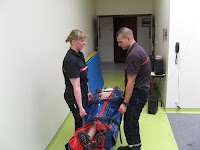There is a basic uniform, used when we work with the VSAV (ambulance). To work with fire, we just add others apparatus on it.
The basic work uniform :

This work uniform is called F1. It's composed of : a jacket, pants and boots (or a kind of boots with laces) like on the left picture. Under the jacket, we wear a tee-shirt or a polo shirt (like on the right picture). When the weather is hot, we are allowed to work without the jacket (except if on the scene we could cut ourselves as for a car crash for example)
The urban fire work uniform :
We keep our basic work uniform (without the jacket) and we put on it ...

the F1 helmet, a cowl under it, a fire jacket, fire pants on top of basic work pants (we call it
surpantalon meaning "on top pants"), a work belt with rack tools for fire gloves and a special hand multispanners (we call it
polycoise meaning "a tool with different spanners in the same tool"), orange fire gloves.
The F1 helmet
 |
F1 helmet includes protecting glasses
against projections of various things. |
 |
| F1 helmet includes a facial screen against fire heat. |
The cowl
Worn under the helmet at any time, it's put under the SCBA to protect the facial skin against burns by the heat of the fire.
The work belt
It has various functions : rack tools (leather clearing gloves and the hand multispanners), barrier against the heat to protect the top of the body).
Watch out ! It's not allowed to use it as a belt of auto-protection against the falls (it's not enough secured to fill this function).
The hand multispanners
As its names indicate it, this spanner is used for various works.
- Help to link hoses
- Open doors and caskets which hide the installations of gas, electricity ...
- Close some gates of gas
- Open some doors of elevator
The wildfire work uniform :
It's the same uniform as for urban fires, except the helmet.

The F2 helmet is used for wildfire or to cut trees fallen because of the bad weather or to work on car crash.

Its color is red to be seen by firefighting aircrafts when they release their water (the color of helmet from the rank of sergeant is white)
The ceremonial uniform :


The enlisted men wear their basic work uniform with the F1 helmet (without the "bottom wing"), the work belt (without rack tools) and a red piece of fabric called
plastron around the blow.

Our pants have on both outside side a red line (all firefighters in France have that). It's a decoration called
Légion d'Honneur (meaning Legion of Honor). This decoration was established by Napoleon 1st on May 19th 1802. Since this date, it reward military or civil eminent merits returned to he Nation. It's the highest French honorary decoration.
Each French department has his own patch for firefighter uniform. This is the Morbihan's one.
At the top it's written
Sapeurs-Pompiers meaning Firefighters.
Behind on the right there's the drawing of a Breton symbol called
Hermine meaning Ermine.
In the middle, there are a green circle and a smaller blue circle inside with two sails of sailboat. It's to explain that our department is by the sea and there's a gulf (we call it Gulf of Morbihan) ; so the green circle means the earth and the blue circle means the sea.
In the Morbihan, we add a decoration called fourragère ( = lanyard ?). Colors are blue, white and red. The first time this decoration was given it was in 1948, to firefighters of the department who fought great fires in the city of Lorient during WWII. These fires were owed to the English bombardments to destroy the German submarine base established in this city. As in many bombardments during WWII, the buildings sheltering the French population were got very often hard. At the end of the war, it was decided to decorate the firefighter corps of the department. Since that date, each firefighter at the end of his/her first year of duty receives this decoration.
This decoration rewards an act of courage and devotion.

























































